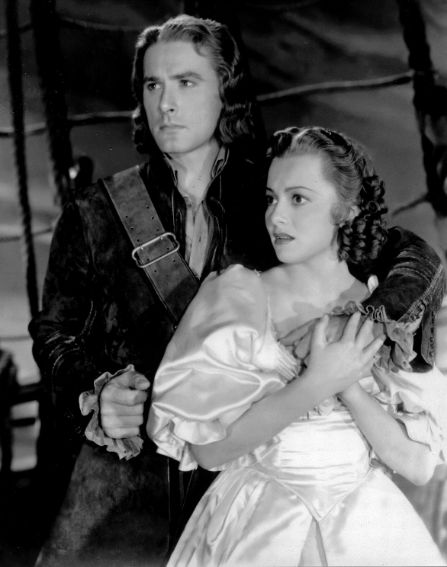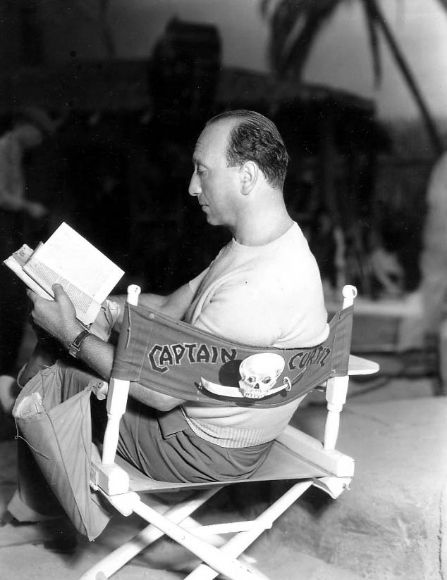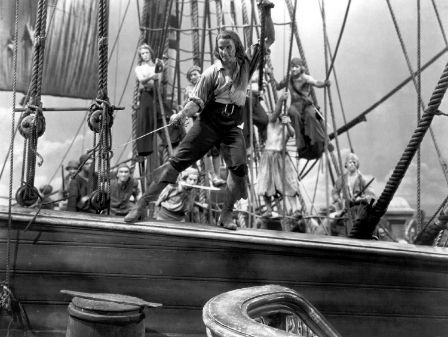Captain Blood screens Tuesday night, May 17, at the Pickwick Theatre.
The following was originally published in the Crossed Swords blog.
Captain Blood (1935) is one of the essentials to any movie series on swashbuckling. It was the film that not only made Errol Flynn a star but kicked off a second cycle of swashbucklers that would continue until the start of World War II. I remember seeing Captain Blood when I was a little buccaneer, and in those pre-Robert Osbourne days, we had Frazier Thomas and “Family Classics” on WGN-TV. This is where I saw all the great Errol Flynn swashbucklers. I watched Captain Blood again recently, and a few things really stood out. I was captivated by Flynn’s performance, of course, but also by the direction, and how well the story fits into the mold of the classic hero tradition.
“It was fortunate for you that I was here to save you.”
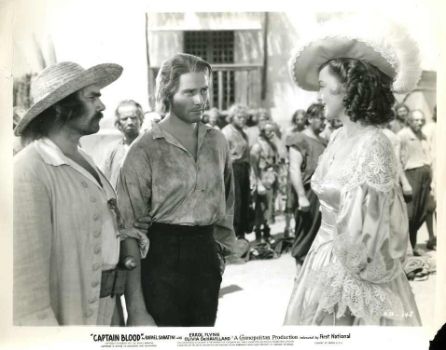
Captain Blood was Flynn’s American debut as a leading man, but you would never know it watching him onscreen. It was certainly daring for Warner Brothers to not only cast him as the lead but also Olivia de Havilland too, who was practically an unknown herself. Both are marvelous in the film. It’s easy to see why they would be paired together seven more times. Flynn is everything we expect a hero to be and more. He is dashing, romantic, and totally convincing with a sword. Flynn is also quite sincere in the role. In later years, he was often dismissive about his costume pictures, but it’s this sincerity in his characterization that makes the film work. He made it all seem so easy, and perhaps this is why he was underrated as an actor.
One of his best scenes comes early in the film after he is arrested for giving medical attention to a rebel of King James II. After months in prison, he finally faces an English magistrate in what becomes a mockery of freedom and equality. Unlike his fellow prisoners, Dr. Peter Blood pleads not guilty to the charges he is accused of doing. We feel his anger at the injustice of the court before him. His dialogue in this scene is some of his best in the movie, and he expresses his anger with great conviction. Throughout the film, he makes several important speeches, and it’s amazing that a relative newcomer to the screen is able to pull it off as well as he does.
Cinematographer Hal Mohr, Errol Flynn, and Michael Curtiz
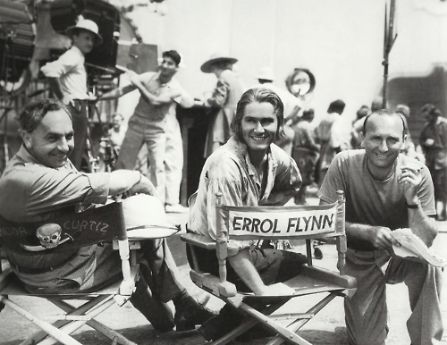
Flynn was reportedly very nervous when production began, but director Michael Curtiz settled him down and got the performance he needed. Curtiz’s handling of his actors produced the desired results. Equally commendable is Curtiz’s atmospheric direction which was well-suited to the genre. Captain Blood is filled with striking shots and use of shadows. A good example of the director’s staging is the aforementioned court scene in which the set is very severe and stark in appearance. Curtiz’s framing and compositions are expressionistic in design. This was certainly the European influence behind his direction. As with Erich Wolfgang Korngold’s musical score, the look and design of Curtiz’s film convey what words cannot.
Captain Blood embodies the hero tradition that audiences would see throughout the 1930s and ‘40s. It has many similarities to The Adventures of Robin Hood, made three years later by the same director. In both films, there is a rebel rallying his men against injustice. In both films, there are corrupt leaders who are ultimately replaced by good kings. But whether the hero was an English outlaw or an Irish doctor, he never sought to overthrow the government or replace the system– only those leaders who had corrupted it.
Olivia de Havilland on the set of Captain Blood. Jean Muir and Anita Louise were first considered for the role.
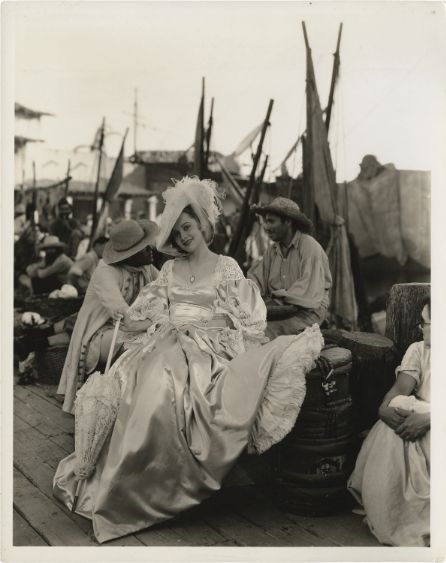
Injustice was a recurring theme at Warner Brothers. Throughout the early 1930s the studio tackled social injustice in contemporary films whose source material came directly from news headlines. One might recall Paul Muni’s unfair sentencing in I Am A Fugitive From A Chain Gang (1932). These themes continued in the historical genre. Social injustice is what’s behind Peter Blood’s desire for revenge. There is injustice and cruelty depicted in the authority figures—from the “unclean tyrant” King James to the magistrate that sentences Peter Blood to the Lionel Atwill character, Bishop, who runs the Port Royal plantation and tortures his slaves with a branding iron. We want to see these antagonists get what’s coming to them. With this as a background, Flynn makes us sympathize and identify with him.
Despite leading the life of a pirate– a life of stolen fortunes and unholy alliances– Peter Blood has a code, as embodied in the articles he draws up on the ship for those under his command. Women, for instance, are not to be taken hostage. And when they are, he sees to it that they are put ashore. It seems that despite his new life as a seafaring rogue, chivalry rides the high seas with him. His wanton ways of buying a woman’s attention with sacks of coins, for instance, are contradicted by his inherent decency towards Arabella Bishop (Olivia de Havilland). Peter Blood reflects life’s contradictions. However, to have gone any further into psychological complexity the film would have ceased to be a swashbuckler. One of the conventions that separates the golden age swashbuckler from the modern one is that they weren’t about social realism. The stories could have themes and conflicts that were relevant, but they always had the fundamental morality and idealism of a hero legend. Characters could be cynical at times, but the tone of the film itself could never be such in the end. Ugly realities were always vanquished by the sword.
Location shooting included Laguna Beach, California.
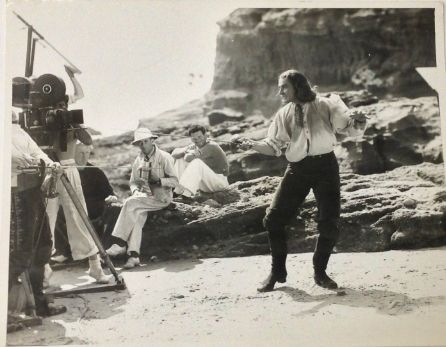
Errol Flynn and Basil Rathbone. (Swordplay staged by Fred Cavens.)

Crossed Swords is the mirror opposite of previous programs like Forbidden Cinema. So often I hear people talk about that pre-Code era in Hollywood (1929-1934) as though that was the only time studios made honest films—movies that featured strong female characters and subjects Hollywood would not tackle again for decades. These same viewers are often dismissive towards the Production Code and the films made under it as though they feel idealism—such as that found in the Crossed Swords series—cannot contain any truth. For this critical circle, the age of chivalry is false, a romantic notion better suited for children’s fairy tales than for adults. But there was a reason these films played on “Family Classics”; it was because they are family films. Not only did they offer a sort of moral guidance for the young and impressionable, but they satisfied a need in people of all ages to believe in what is best in human nature.
Some of Hollywood’s finest examples of storytelling were in fact made under the Production Code. The swashbucklers might not have been “realistic,” but they could still contain an emotional truth which can be more powerful than realism. In addition to this, they managed to tackle subjects that were not only relevant then– but today as well. Just last week one of our patrons came up to me after our screening of The Count of Monte Cristo and referenced the corrupt banking practices that Edmond Dantes sought to expose. (It’s a familiar issue to our modern society!) And here in Peter Blood we have a character who is a reflection of our own frustrations. How many of us have no use for our current political leaders? Yet we always seem to unite in a crisis (and war), and there is always a hope of a great unifier in some distant future. In our swashbucklers, it was always a good King who restored the peace and happiness and changed the shape of the world. For Peter Blood, his reputation is restored with the ascendancy of King William. This was the dynamic of the classic swashbuckler. It’s a testament to these films that they resonate with us so much all these years later.
~MCH
